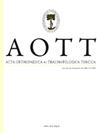The effects of different cortical impingement scenarios on the biomechanical features of retrograde femoral nails in the management of distal femoral fractures: A finite element analysis
IF 1.1
4区 医学
Q3 ORTHOPEDICS
引用次数: 0
Abstract
Objective: This study aimed to assess the effects of different cortical impingement scenarios on the biomechanical features of retrograde femoral nails in managing distal femoral fractures. Methods: A mesh femur model was constructed using computed tomography (CT) images. Five different cortical impingement (CI) scenarios were designed: central model (CM), lateral CI (LCI), medial CI (MCI), anterior CI (ACI), and posterior CI (PCI). The fixation stability was evaluated by femoral head movement, stress, and elastic strain at the fracture site. The maximum stress on the femoral cortex and the implants were also measured. Results: The maximal femoral head movements were 3.11 mm in ACI and 2.91 mm in MCI. Among all CI models, the highest stress value at the fracture site was recorded in ACI (18.9 MPa), and the maximum stress on the femoral cortex was determined in ACI (114.3 MPa). The highest microstrain value at the fracture site was measured in MCI (599.1 μstrain). In all scenarios, maximum stress was located around the proximal hole of the nail. Conclusion: This study revealed that cortical impingement results in excessive loading on the retrograde femoral nail in managing distal femur fractures. MCI and ACI mainly cause this pathological loading. Problems related to supraphysiological loadings, such as implant failure and periprosthetic fracture, can be reduced by applying the nail in the central position.不同皮质撞击情况对股骨远端骨折逆行股骨钉生物力学特征的影响:有限元分析
目的:本研究旨在评估不同皮质撞击情况对逆行股骨钉治疗股骨远端骨折生物力学特征的影响。方法:利用计算机断层扫描(CT)图像构建网状股骨模型。设计了五种不同的皮质撞击(CI)场景:中央模型(CM)、外侧CI (LCI)、内侧CI (MCI)、前路CI (ACI)和后路CI (PCI)。通过股骨头运动、应力和骨折部位的弹性应变来评估固定稳定性。同时测量股骨皮质和植入物的最大应力。结果:ACI股骨头最大运动为3.11 mm, MCI股骨头最大运动为2.91 mm。在所有CI模型中,ACI模型骨折部位应力值最高(18.9 MPa), ACI模型股骨皮质应力值最大(114.3 MPa)。断裂部位微应变值最高的是MCI (599.1 μstrain)。在所有情况下,最大应力位于钉的近端孔周围。结论:本研究揭示皮质撞击导致股骨远端骨折逆行股内钉负荷过大。MCI和ACI主要引起这种病理性负荷。与超生理负荷相关的问题,如种植体失败和假体周围骨折,可以通过在中心位置应用钉子来减少。
本文章由计算机程序翻译,如有差异,请以英文原文为准。
求助全文
约1分钟内获得全文
求助全文
来源期刊

Acta orthopaedica et traumatologica turcica
ORTHOPEDICS-
CiteScore
2.00
自引率
0.00%
发文量
66
审稿时长
>12 weeks
期刊介绍:
Acta Orthopaedica et Traumatologica Turcica (AOTT) is an international, scientific, open access periodical published in accordance with independent, unbiased, and double-blinded peer-review principles. The journal is the official publication of the Turkish Association of Orthopaedics and Traumatology, and Turkish Society of Orthopaedics and Traumatology. It is published bimonthly in January, March, May, July, September, and November. The publication language of the journal is English.
The aim of the journal is to publish original studies of the highest scientific and clinical value in orthopedics, traumatology, and related disciplines. The scope of the journal includes but not limited to diagnostic, treatment, and prevention methods related to orthopedics and traumatology. Acta Orthopaedica et Traumatologica Turcica publishes clinical and basic research articles, case reports, personal clinical and technical notes, systematic reviews and meta-analyses and letters to the Editor. Proceedings of scientific meetings are also considered for publication.
The target audience of the journal includes healthcare professionals, physicians, and researchers who are interested or working in orthopedics and traumatology field, and related disciplines.
 求助内容:
求助内容: 应助结果提醒方式:
应助结果提醒方式:


